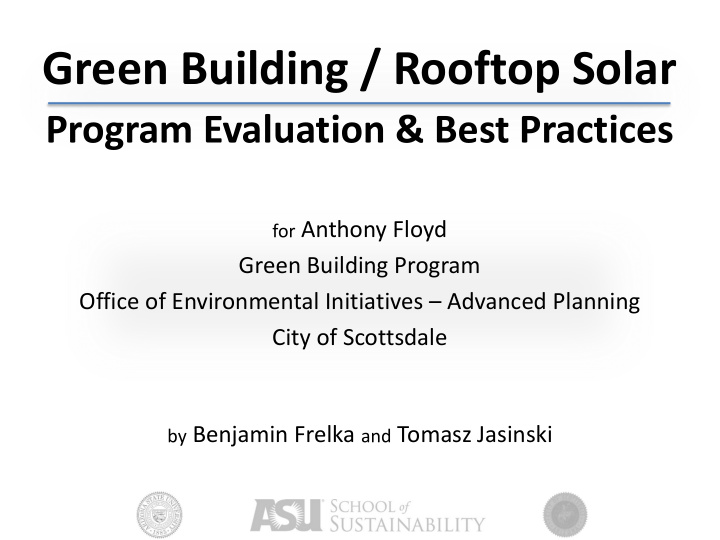



Green Building / Rooftop Solar Program Evaluation & Best Practices for Anthony Floyd Green Building Program Office of Environmental Initiatives – Advanced Planning City of Scottsdale by Benjamin Frelka and Tomasz Jasinski
Purpose Exploring leading Green Building and Rooftop Solar Programs to identify best practices and improve competitiveness of the Scottsdale initiatives Green Building Program: • voluntary or mandatory requirements for new construction or remodeling of residential and commercial buildings, with performance guidelines for energy, water, and material usage of building construction and operation. Rooftop Solar Program: • program for encouraging home owners and developers to engage in residential and commercial photovoltaic solar projects, in new construction or retrofitting.
Methods Green Building – Researched Green Building Programs in USA – Identified relevant Best Practices documents Rooftop Solar – Researched Rooftop PV Programs in USA – Identified 4 current Best Practices documents – Minimizing Overlap in PV System Approval Processes – Simplifying the Solar Permitting Process – California Solar Permitting Guidebook – emPower Arizona Energy Assessment
Scottsdale’s Green Building Program • Premier Green Building Programs • Why so successful? • Lessons learned and future implications
History / Overview • Officially established in 1998 • Rating criteria based on characteristics of the Sonoran Bioregion • Integrated with the city’s existing development process to assist with building permits, reviews, and inspections • Site use, energy, building materials, indoor air quality, solid waste and water usage • Green Building Advisory Committee • LEED, IgCC
Benefits • Expedited building plan review and process assistance • Differentiated developers in the market • Increased public involvement, education, and community involvement
Success Attributes • “Going Beyond Code” Keys to Success 1) Clear Goals 2) Community Wide Assessment and Planning 3) Stake Holders in Decision Process 4) Implementation and Integration 5) Incentives 6) Communication and Partnerships
Current State and Future Impact • Scaled down due to economic downturn, budget cuts • Towards Advanced Solutions for Achieving Sustainability Goals in Buildings: Lessons Learned from Case Studies by American Society of Civil Engineers – Largest Impact falls on planning and doing in phases – Integrated design & stakeholder collaboration are key – Success based on acquisition & accumulation of knowledge • Has accomplished goal of offering lessons learned
Green Vision • Scaled • Fdfdf • Fdfdfd • fdfdfd
PII of Soft BoS • PV Balance of System (BoS) Soft Costs for residential systems. • 18,000+ U.S. municipalities set their own solar permitting requirements • Inefficient The Interstate permitting adds $1-2K in cost.
Simplifying solar permitting process • Nine Residential Solar Permitting Best Practices: – Post Requirements Online – Implement an Expedited Permit Process – Enable Online Permit Processing (Scottsdale) – Ensure a Fast Turn Around Time (Scottsdale) – Collect Reasonable Permitting Fees – Do Not Require Community-Specific Licenses – Offer a Narrow Inspection Appointment Window – Eliminate Excessive Inspections (Scottsdale) – Train Permitting Staff in Solar
California Solar Permitting Guidebook • Streamlining Small PV Installations • PV Toolkit for Expedited Permitting – Submittal Requirements Bulletin – Eligible Checklist for Expedited Permitting – Standard Plan – central inverters – Standard Plan – micro-inverters – Structural Criteria for Flush Mounted Arrays – Plan Review & Inspection Guide
Minimizing Overlap in PV Approvals • Installers must get customers, line up financing, and navigate multiple approval processes BEFORE installing rooftop systems: – obtaining interconnection agreement from the utility – securing a building/electrical permit from local gov. – obtaining historic district approval – enrolling in a net metering program – applying for state or local rebates/incentives • We must speed up review/approval processes
emPower Arizona • Arizona faces 3 solar challenges: – decreasing demand (utilities ahead of goals) – financing (not at grid-parity) – restricted export (transmission infrastructure near capacity) • Likely little solar demand from utilities • Grid-parity targeted at $0.09/kWh in 10 yrs
Solar Vision • Energy policies will require more renewables • Solar will become most cost-effective renewable • Distributed PV solar will dominate all renewables • The Valley of the Sun will become a solar center • Scottsdale has space and resources (1/2 pop. density of Phoenix)
Why Solar here? • Desert conditions ( sun / heat /water) • Best solar conditions in USA • Fresh Water $ ↑ • Grid Electricity $ ↑ • Installed Solar $ ↓ 1. Runs on unlimited, free sunshine 2. Uses zero water 3. Provides cooling shade 4. Is efficient on micro-grid scale
Recommendation • You do many things right and early • Reduce, Simplify, Eliminate (paperwork, fees) • Be daring (represent your residents/businesses) – Negotiate better deals – Offer more incentives (to live, work, build) – Facilitate rebates, tax credits, incentives – Support local sourcing – Help finance projects (make local SolarCity) • Become a troubleshooter – planning, financing, design, engineering, permitting, procurement, construction/installation, service, maintenance, operation
Recommend
More recommend